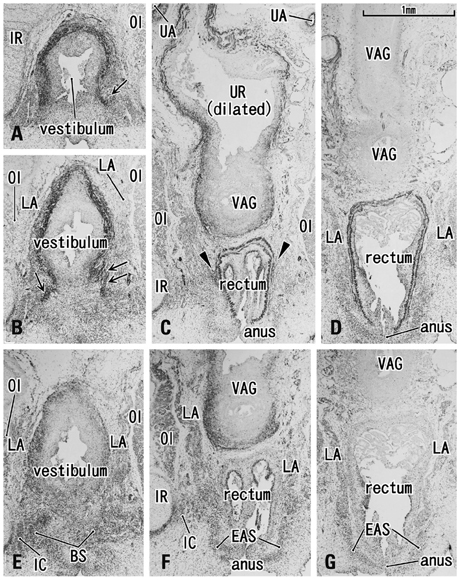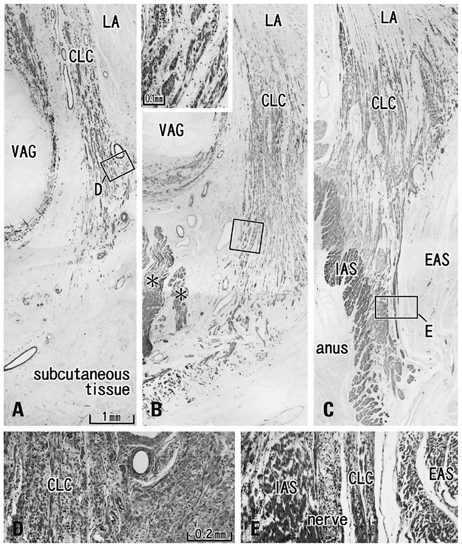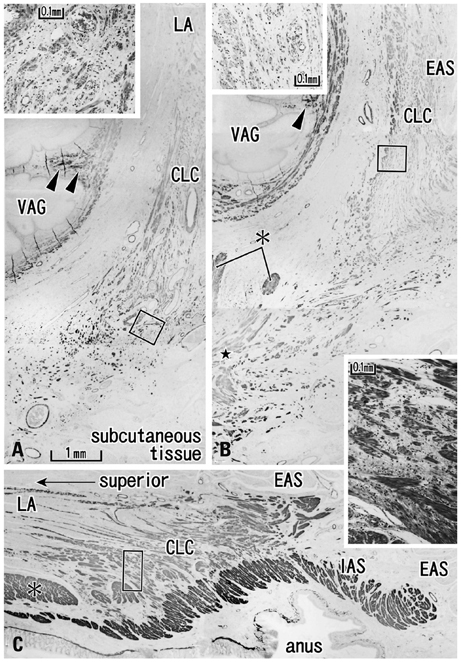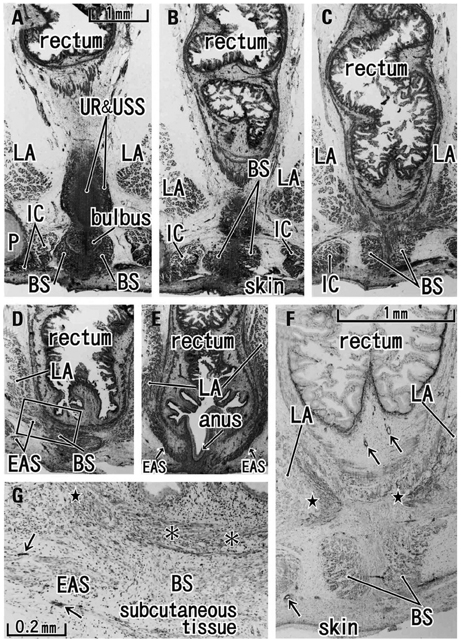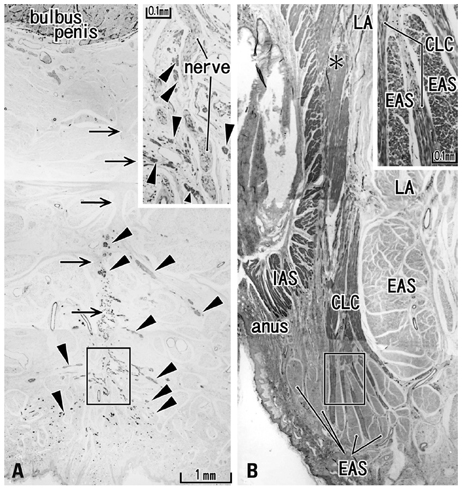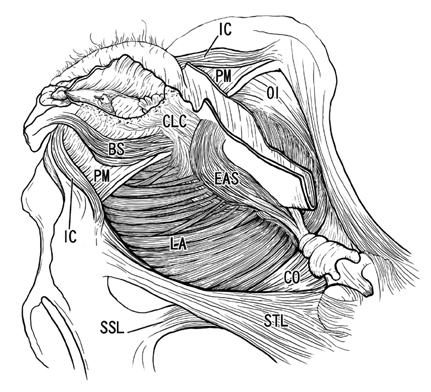Yonsei Med J.
2013 May;54(3):778-784. 10.3349/ymj.2013.54.3.778.
Female Longitudinal Anal Muscles or Conjoint Longitudinal Coats Extend into the Subcutaneous Tissue along the Vaginal Vestibule: A Histological Study Using Human Fetuses
- Affiliations
-
- 1Division of Colon and Rectal Surgery, Shizuoka Cancer Center Hospital, Shizuoka, Japan. y.kinugasa@scchr.jp
- 2Arakawa Clinic of Proctology, Tokyo, Japan.
- 3Department of Anatomy, Akita University School of Medicine, Akita, Japan.
- 4Department of Anatomy and Embryology II, Faculty of Medicine, Complutense University, Madrid, Spain.
- 5Division of Internal Medicine, Iwamizawa Kojin-Kai Hospital, Iwamizawa, Japan.
- 6Department of Surgical Oncology, Graduate School, Tokyo Dental and Medical University, Tokyo, Japan.
- KMID: 1727897
- DOI: http://doi.org/10.3349/ymj.2013.54.3.778
Abstract
- PURPOSE
It is still unclear whether the longitudinal anal muscles or conjoint longitudinal coats (CLCs) are attached to the vagina, although such an attachment, if present, would appear to make an important contribution to the integrated supportive system of the female pelvic floor.
MATERIALS AND METHODS
Using immunohistochemistry for smooth muscle actin, we examined semiserial frontal sections of 1) eleven female late-stage fetuses at 28-37 weeks of gestation, 2) two female middle-stage fetus (2 specimens at 13 weeks), and, 3) six male fetuses at 12 and 37 weeks as a comparison of the morphology.
RESULTS
In late-stage female fetuses, the CLCs consistently (11/11) extended into the subcutaneous tissue along the vaginal vestibule on the anterior side of the external anal sphincter. Lateral to the CLCs, the external anal sphincter also extended anteriorly toward the vaginal side walls. The anterior part of the CLCs originated from the perimysium of the levator ani muscle without any contribution of the rectal longitudinal muscle layer. However, in 2 female middle-stage fetuses, smooth muscles along the vestibulum extended superiorly toward the levetor ani sling. In male fetuses, the CLCs were separated from another subcutaneous smooth muscle along the scrotal raphe (posterior parts of the dartos layer) by fatty tissue.
CONCLUSION
In terms of topographical anatomy, the female anterior CLCs are likely to correspond to the lateral extension of the perineal body (a bulky subcutaneous smooth muscle mass present in adult women), supporting the vaginal vestibule by transmission of force from the levator ani.
MeSH Terms
Figure
Reference
-
1. Macchi V, Porzionato A, Stecco C, Vigato E, Parenti A, De Caro R. Histo-topographic study of the longitudinal anal muscle. Clin Anat. 2008. 21:447–452.
Article2. Shafik A. New concept of the anatomy of the anal sphincter mechanism and the physiology of defecation. II. Anatomy of the levator ani muscle with special reference to puborectalis. Invest Urol. 1975. 13:175–182.3. Borley NR. Standring S, editor. Anal canal. Gray's Anatomy. 2008. 40th ed. London: Elsevier Churchill Linvingstone;1155–1160.4. Arakawa T, Murakami G, Nakajima F, Matsubara A, Ohtsuka A, Goto T, et al. Morphologies of the interfaces between the levator ani muscle and pelvic viscera, with special reference to muscle insertion into the anorectum in elderly Japanese. Anat Sci Int. 2004. 79:72–81.
Article5. Murakami G, Nakajima F, Sato TJ, Tsugane MH, Taguchi K, Tsukamoto T. Individual variations in aging of the male urethral rhabdosphincter in Japanese. Clin Anat. 2002. 15:241–252.
Article6. Hirata E, Fujiwara H, Hayashi S, Ohtsuka A, Abe S, Murakami G, et al. Intergender differences in histological architecture of the fascia pelvis parietalis: a cadaveric study. Clin Anat. 2011. 24:469–477.
Article7. Brooks JD, Eggener SE, Chao WM. Anatomy of the rectourethralis muscle. Eur Urol. 2002. 41:94–100.
Article8. Porzionato A, Macchi V, Gardi M, Parenti A, De Caro R. Histotopographic study of the rectourethralis muscle. Clin Anat. 2005. 18:510–517.
Article9. Matsubara A, Murakami G, Arakawa T, Yasumoto H, Mutaguchi K, Akita K, et al. Topographic anatomy of the male perineal structures with special reference to perineal approaches for radical prostatectomy. Int J Urol. 2003. 10:141–148.
Article10. Uchimoto K, Murakami G, Kinugasa Y, Arakawa T, Matsubara A, Nakajima Y. Rectourethralis muscle and pitfalls of anterior perineal dissection in abdominoperineal resection and intersphincteric resection for rectal cancer. Anat Sci Int. 2007. 82:8–15.
Article11. Petros P. The female pelvic floor. 2004. Heidelberg: Springer.12. Hayashi S, Murakami G, Ohtsuka A, Itoh M, Nakano T, Fukuzawa Y. Connective tissue configuration in the human liver hilar region with special reference to the liver capsule and vascular sheath. J Hepatobiliary Pancreat Surg. 2008. 15:640–647.
Article13. Miyake N, Hayashi S, Kawase T, Cho BH, Murakami G, Fujimiya M, et al. Fetal anatomy of the human carotid sheath and structures in and around it. Anat Rec (Hoboken). 2010. 293:438–445.
Article14. Soga H, Nagata I, Murakami G, Yajima T, Takenaka A, Fujisawa M, et al. A histotopographic study of the perineal body in elderly women: the surgical applicability of novel histological findings. Int Urogynecol J Pelvic Floor Dysfunct. 2007. 18:1423–1430.
Article15. DeLancey JO. Structural anatomy of the posterior pelvic compartment as it relates to rectocele. Am J Obstet Gynecol. 1999. 180:815–823.
Article16. Kato M, Matsubara A, Murakami G, Abe S, Ide Y, Sato I, et al. Female perineal membrane: a study using pelvic floor semiserial sections from elderly nulliparous and multiparous women. Int Urogynecol J Pelvic Floor Dysfunct. 2008. 19:1663–1670.
Article17. van der Putte SC. The devlopment of the perineum in the human. A comprehensive histological study with a special reference to the role of the stromal components. Adv Anat Embryol Cell Biol. 2005. 177:1–131.18. Murphy F, Puri P, Hutson JM, Holschneider AM. Holschneider AM, Hutson JM, editors. Incidence and frequency of different types, and classification of anorectal malformations. Anorectal Malformations in Children. 2006. 40th ed. Berlin Heidelberg: Springer;163–184.
Article19. Stephens FD. Holschneider AM, Hutson JM, editors. Photographic album of anorectal malformations and the sphincter muscles. Anorectal Malformations in Children. 2006. 40th ed. Berlin Heidelberg: Springer;87–142.20. van der Putte SC. The development of the human anorectum. Anat Rec (Hoboken). 2009. 292:951–954.
Article
- Full Text Links
- Actions
-
Cited
- CITED
-
- Close
- Share
- Similar articles
-
- Perineal raphe with special reference to its extension to the anus: a histological study using human fetuses
- Reappraisal of intergender differences in the urethral striated sphincter explains why a completely circular arrangement is difficult in females: a histological study using human fetuses
- Development and growth of the temporal fascia: a histological study using human fetuses
- A Case of Retinoblastoma and Coats' Disease in the Same eye: A Clinicopathologic Report
- Anococcygeal Raphe Revisited: A Histological Study Using Mid-Term Human Fetuses and Elderly Cadavers

